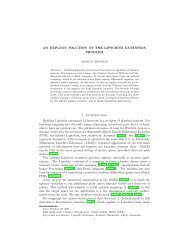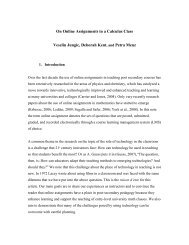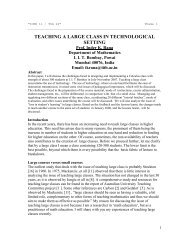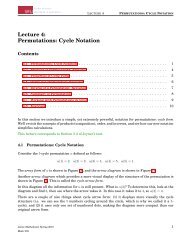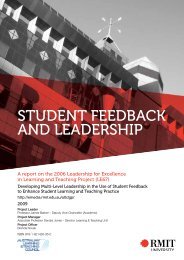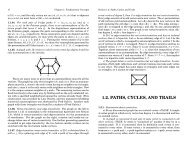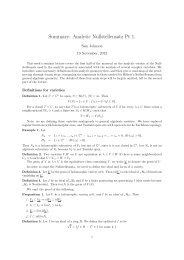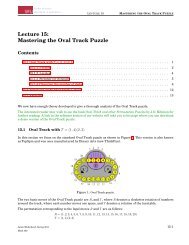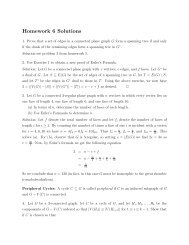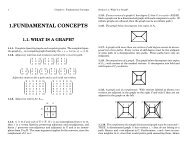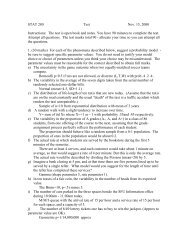Math Girl Begins - People.stat.sfu.ca - Simon Fraser University
Math Girl Begins - People.stat.sfu.ca - Simon Fraser University
Math Girl Begins - People.stat.sfu.ca - Simon Fraser University
Create successful ePaper yourself
Turn your PDF publications into a flip-book with our unique Google optimized e-Paper software.
EDUCATION NOTES<br />
continued<br />
compli<strong>ca</strong>ted phenomena and often we are able to get<br />
information about the degree of our imprecision. In<br />
<strong>Math</strong> <strong>Girl</strong>’s words, “Close enough is sometimes good<br />
enough.”<br />
Motivated by Dr. Jonathan Borwein’s remark that<br />
“in mathematics sometimes it is easier to see than<br />
to say ” in early 2004 the author met with Mr. Jesai<br />
Jayhmes, an actor and director, to discuss the options<br />
of creating an animated video. The original idea<br />
was to make a film in which the small image of a<br />
math instructor would be seen traveling along the<br />
graph of a function and one of its tangent lines.<br />
While doing so the instructor would demonstrate the<br />
principles and properties of the linear approximation<br />
and differentials. This proposal was deemed to be too<br />
expensive and the notion of a <strong>ca</strong>rtoon was brought<br />
up. Next, together with Mr. Lou Crockett, an artist,<br />
animator, and designer, Mr. Jayhmes and the author<br />
<strong>ca</strong>me up with the idea of creating a superhero, who<br />
would personify all mathemati<strong>ca</strong>l knowledge. The<br />
choice of a female character was easy. On a midterm<br />
in a 500 student strong <strong>ca</strong>lculus class, taught by the<br />
author of this note in 2002, only one student got 100<br />
per cent and, when the student was asked to stand<br />
up, a tiny young woman reluctantly rose in the large<br />
lecture hall. <strong>Math</strong> <strong>Girl</strong> was born.<br />
Three <strong>ca</strong>rtoon movies, Differentials Attract, Zero!’s<br />
Dis-Continuity, and Rationalize This!, about the<br />
adventures of <strong>Math</strong> <strong>Girl</strong>, a super heroine who uses<br />
her super knowledge of mathematics to protect<br />
the citizens of Calculopolis from the evil plots of a<br />
villain <strong>ca</strong>lled Zero! have been created so far. Each<br />
episode is a short story in which the plot is based<br />
on a particular math object and its properties. The<br />
episodes are independent of each other. The ambition<br />
of the authors of the shorts was to accomplish two<br />
goals: to use a pop-culture medium to give a new<br />
view (or use) of the well known mathemati<strong>ca</strong>l objects<br />
and at the same time to enrich the medium itself by<br />
introducing mathematics as a subject. <strong>Math</strong>ematics<br />
in the movies is strict but not detailed enough to be<br />
self-contained. In following with the medium’s clichés,<br />
the stories are based on the fight between good and<br />
evil; where good is a synonym for mathemati<strong>ca</strong>l<br />
knowledge. In her civilian clothes <strong>Math</strong> <strong>Girl</strong> is an<br />
ordinary student, a smart girl who wears glasses.<br />
When she takes her superpower alter ego, thanks<br />
to her superb understanding of mathematics, <strong>Math</strong><br />
<strong>Girl</strong> becomes a super heroine. Other characters<br />
introduced in the <strong>Math</strong> <strong>Girl</strong> movies are <strong>Math</strong> <strong>Girl</strong>’s<br />
sidekick Pat Thagoras, a young man who admires<br />
<strong>Math</strong> <strong>Girl</strong>; professorial Big <strong>Math</strong>, the mayor of<br />
Calculopolis; and Zero!, the evil character whose<br />
goal is to rule Calculopolis by exploiting people’s<br />
ignorance of mathematics. Characters’ appearances<br />
were inspired by Manga 1 images. The movies might<br />
be seen as a benign parody of both the pop medium<br />
and scholarship and this makes the audience often<br />
react with laughter at scenes. It is a fact that even<br />
planning to step outside of the standard delivery<br />
of an edu<strong>ca</strong>tional topic requires the involvement of<br />
people with various skills and expertise. Also, in its<br />
initial phase a proposal of creating a new type of an<br />
edu<strong>ca</strong>tional resource must be general and flexible<br />
enough to accommodate a range of constraints<br />
that may emerge during the process. There are two<br />
necessary conditions for moving the project forward.<br />
The first is to form a team of people willing to put their<br />
talents together towards making a joint product. The<br />
other is to secure enough funds to complete the task<br />
in a satisfactory manner. To meet those two conditions<br />
in a<strong>ca</strong>demia is not a quick and simple procedure 2 .<br />
The biggest challenge for the authors of the <strong>Math</strong> <strong>Girl</strong><br />
movies was to find the balance between the necessary<br />
mathematics and the flow of the story. The problem<br />
could be described as: what to show, what to say,<br />
and how to wrap everything up so that the viewer<br />
sees beyond three-fingered human-like images. In<br />
addition, the intent was to demonstrate to the viewer<br />
a range of properties of the particular mathemati<strong>ca</strong>l<br />
phenomenon. The general approach that the authors<br />
had chosen was to keep all of the mathematics as<br />
simple as possible. This, for example, meant to repeat<br />
a <strong>ca</strong>tchy phrase that gave the idea of approximation<br />
(“Close enough is sometimes good enough”), to loosen<br />
mathemati<strong>ca</strong>l language whenever it was possible (“The<br />
differential is very small, so I <strong>ca</strong>n easily reach you,<br />
Pat”), to materialize mathemati<strong>ca</strong>l objects (”Square<br />
Root Mountain”, “Linear Approximator”, “Sine T Over<br />
T Roller Coaster”, “Epsilon - Delta Device”) etc.<br />
During the process some mathemati<strong>ca</strong>l details were<br />
omitted. For example, a graph showing a differentiable<br />
function, its tangent line, together with the increments<br />
of independent and dependent variables for both the<br />
function and the tangent line, and the differential was<br />
part of the script for the episode <strong>ca</strong>lled Differentials<br />
Attract. After a long discussion it was decided to omit<br />
the graph from the <strong>ca</strong>rtoon. The reason was that the<br />
information contained in it could not be absorbed in<br />
a few seconds, the time that the graph would appear<br />
on the screen.<br />
1 For more about Manga, The Art to Anime, please see http://www.manga.com/<br />
2 The funds for the <strong>Math</strong> <strong>Girl</strong> movies were obtained from the following sources: the Department of <strong>Math</strong>ematics at <strong>Simon</strong> <strong>Fraser</strong> <strong>University</strong> (SFU),<br />
the Faculty of Applied Science at SFU, the Faculty of Science at SFU, the Interdisciplinary Research in <strong>Math</strong>ematics and Computational Sciences<br />
Centre (IRMACS) at SFU, the Learning and Instructional Development Centre (LIDC) at SFU, and an NSERC PromoScience Grant.<br />
VOLUME 39 NO. 8 — DEC 2007 9



